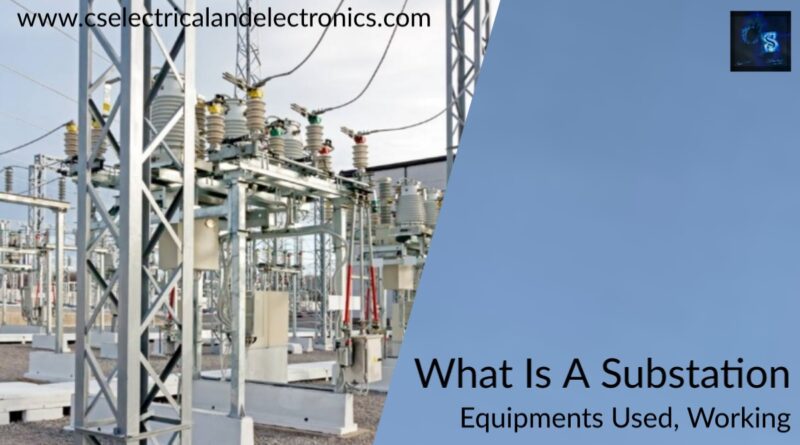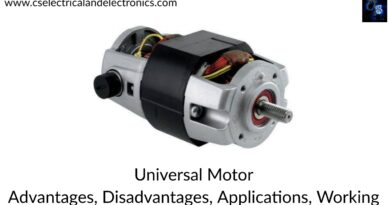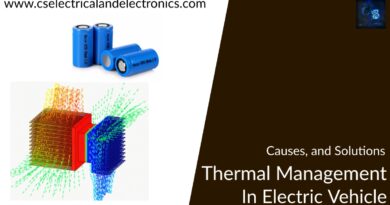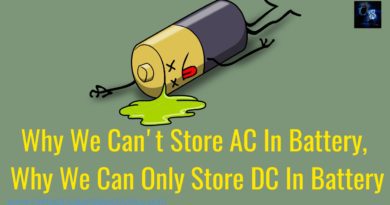What Is A Substation, Equipment In The Substation, 33/11 KV Substation
Hello guys, welcome back to my blog. In this article, I will discuss what is a substation, the equipment used in the substation, what is 33/11 KV substation, working of the equipment used.
If you have any electrical, electronics, and computer science doubts, then ask questions. You can also catch me on Instagram – CS Electrical & Electronics And Chetan Shidling.
Also, read:
- Speed Control Methods For Different Motors, AC Motor, DC Motor
- Top 10 Fuel Cell Manufacturing Companies In The World In 2022
- Different Types Of Lithium-Ion Batteries, Working, Applications
What Is A Substation
33/11KV, Air Insulated substation (AIS), where 33KV-incoming line & 11KV -outgoing line
Substation: It is stationed where we can control the electrical supply of a particular area. There are different types according to voltage level, constructions, etc. Every substation has its Single line diagram where all details are denoted like rating of all equipment, connections, places, and locations.
Equipment In The Substation
Control room
where the operator sited to control substation here alarm is placed he knows every interruption. (Maybe fault, tripping, 33KV breakdown, and burning of cables)
Battery room
Batteries are connected in series to produce DC supply (maybe 110V or 220V only the control voltage of every substation) supply with a battery charger. It Contains boost or float mode when we want fast charging of batteries to use boost mode if we want slowly charging of batteries to use float mode.
Switchyard
It contains the following equipment.
01. Power transformer: The transformer is the heart of the electrical system. Its work is to step down the voltage level from 33 to 11 kV.
02. Instrument Transformer: These are the transformer used for protection & measurement purposes. There are two types of instruments transformer: Current Transformer (CT) and Potential Transformer (PT). Here if we consider 11Kv to measure high current, the current transformer is used. To measure the voltage of the station, the potential transformer is used.
03. Circuit breaker: For making and breaking purposes, breakers are used. We can break (cut off) the supply of particular feeders by this. Also, breakers are tripped (off) in a faulty condition. Each feeder individual has a circuit breaker. Usually, here we use an Air circuit breaker
04. Bus Bar: These are bundled conductors where we can connect several feeders, loads, or connections. If there is one Bus bar 11KV on which we can connect Feeder -1, Feeder-2, Feeder-3(It may be the name of villages or particular residency), and so on.
05. Feeders: By using feeders we can control the electricity in a particular area.
06. Lightning arrester: Used for protection. Located at incoming line i.e. 33KV one terminal connected to Ground & one is on the line. When there is a lightning stroke fall at that time it discharges from the ground terminal.
07. Capacitor bank: Used to maintain power factor unity to avoid penalties from the state electricity board. It must be maintained unity.
08. Insulators: Mainly two types of insulators used pin type for up to 11 kV and suspension type for above 33KV
09. Mounting structure: Used to carry conductors and jumpers also for mounting isolators.
10. Station transformer: Used for building lighting as a Backup supply.
11. Cables: They are used to carry electricity from the battery room to feeders, measuring meters, transformer, control, and relay panels.
12. Isolators: These act as a switch. Located forward and backside of a circuit breaker. operates under no-load conditions manually.
Earthing
It is essential for the substation to discharge leakage current. There are two types of earthing, first is pipe earthing, and the second is Plate earthing. Earthing is made of charcoal, salt, and water. Earthing may be in a grid or individual. Usually, CU or AL metal is used for Earthing but due to the cost of Cu being high we prefer Aluminium.
LT Panels
For lightning of all switchyard, LT panels are used.
I hope this article “What Is A Substation” may help you all a lot. Thank you for reading.
Also, read:
- Top 100 HiL hardware in loop Interview Questions With Answers For Engineers
- Top 100 Automotive Interview Questions With Answers For Engineers
- How Renewable Energy Is Transforming Electrical Engineering
- Exploring Electric Vehicles: Technology and Challenges
- The Future of Power Systems: Smart Grids
- What is XCP (Universal Measurement and Calibration Protocol)? Introduction, Working, Purpose, Applications
- What Is SIL Testing, Software-In Loop, Working, Purpose
- UDS (Unified Diagnostic Services) Tutorials For Automotive Engineers
Author Profile
- Chetu
- Interest's ~ Engineering | Entrepreneurship | Politics | History | Travelling | Content Writing | Technology | Cooking
Latest entries
 All PostsApril 19, 2024What Is Vector CANoe Tool, Why It Is Used In The Automotive Industry
All PostsApril 19, 2024What Is Vector CANoe Tool, Why It Is Used In The Automotive Industry All PostsApril 13, 2024What Is TCM, Transmission Control Module, Working, Purpose,
All PostsApril 13, 2024What Is TCM, Transmission Control Module, Working, Purpose, All PostsApril 12, 2024Top 100 HiL hardware in loop Interview Questions With Answers For Engineers
All PostsApril 12, 2024Top 100 HiL hardware in loop Interview Questions With Answers For Engineers All PostsMarch 22, 2024Driver Monitoring Systems In Vehicles, Working, Driver Sleepy Alert
All PostsMarch 22, 2024Driver Monitoring Systems In Vehicles, Working, Driver Sleepy Alert








